Share AZ-103 Microsoft Azure Administrator dumps | latest study guide for the AZ-103 exam
This is the AZ-103 Microsoft Azure Administrator Practice Test issue.From https://www.pass4itsure.com/az-103.html latest az-103 study guide.This is the highest pass rate of az-103 dumps in 2019.which has a 332+ exam question and answer with a detailed explanation. Very useful for preparing for AZ-103 exam.

Are you going to take the az-103 exam?-Have a look at our

Exam AZ-103 ?
Starting on May 1, 2019, you only need to pass Exam AZ-103 to earn this certification. This new exam combines the skills covered in AZ-100 and AZ-101 (which retired on May 1, 2019), with the majority of the new exam coming from AZ-100.You will learn how to manage subscriptions and resources on Microsoft Azure, how to implement and manage virtual machines and networks, and how to secure identities in the cloud.
Need to know(Please use the link below to learn more)
Manage Azure subscriptions and resources (15-20%)
Implement and manage storage (15-20%)
Deploy and manage virtual machines (VMs) (15-20%)
Configure and manage virtual networks (30-35%)
Manage identities (15-20%)
- Add or change Azure subscription administrators
- Administrator role permissions in Azure Active Directory
- View and assign administrator roles in Azure Active Directory
- Assign administrator and non-administrator roles to users with Azure Active Directory
- Azure subscription and service limits, quotas, and constraints
- Manage and request quotas for Azure resources
- Use tags to organize your Azure resources
- Sample – Enforce tag and its value
- Sample – Billing tags policy initiative
- Use tags to organize your Azure resources
- Prevent unexpected charges with Azure billing and cost management
- Add or change Azure subscription administrators
- Overview of the Azure Policy service
- Tutorial: Create and manage policies to enforce compliance
- Azure Policy definition structure
- Overview of alerts in Microsoft Azure
- Create, view, and manage activity log alerts using Azure Monitor
- Create, view, and manage log alerts using Azure Monitor
- Using functions in Azure Monitor log queries
- Tutorial: Create and manage policies to enforce compliance
- Move resources to new resource group or subscription
- Custom roles for Azure resources
- Configure Azure Storage firewalls and virtual networks
- Manage storage account settings in the Azure portal
- Azure Storage redundancy
- What is a content delivery network on Azure?
- Manage the availability of Windows virtual machines in Azure
- Manage the availability of Linux virtual machines
- Quickstart: Create a Windows virtual machine in Azure with PowerShell
- Quickstart: Create a Windows virtual machine with the Azure CLI
- Configure a VNet-to-VNet VPN gateway connection using PowerShell
- Configure a VNet-to-VNet VPN gateway connection using Azure CLI
- Add or delete users using Azure Active Directory
- Create a basic group and add members using Azure Active Directory
- Azure Event Grid and Azure Logic Apps (az-101-02b)
- Azure AD Identity Protection (az-101-04b)
- Azure Network Watcher (az-101-03b)
- Configure Azure DNS (az-100-04b)
- Deploy and Manage Virtual Machines (az-100-03)
- Governance and Compliance (az-100-01b)
- Implement and Manage Azure Web Apps (az-101-02)
- Implement ASR Between Regions (az-101-01)
- Implement Directory Synchronization (az-100-05)
- Implementing File Sync (az-100-02b)
- Implement and Manage Storage (az-100-02)
- Load Balancer and Traffic Manager (az-101-03)
- Migrate On-premises Hyper-V VMs to Azure (az-101-01b)
- Role-Based Access Control (az-100-01)
- Self-Service Password Reset (az-100-05b)
- Virtual Machines and Scale Sets (az-100-03b)
- VNet Peering and Service Chaining (az-100-04
Please refer to here for details.
Share some documents and data for preparation for exam (AZ-103)

Preparation is the key to passing the exam.
Path:
- Instructor-led training (Microsoft Official Courses)
- Books
- Video
- Practice Exams
| Learning path | Introduction | URL |
| Instructor-led training (Microsoft Official Courses) | Azure Administrators use the Azure Portal and as they become more proficient they use PowerShell and the Command Line Interface. | https://www.microsoft.com/en-us/learning/course.aspx?cid=AZ-103T00 |
| Books | 1.Exam Ref AZ-103 Microsoft Azure Administrator 2.Microsoft Azure Administrator – Exam Guide AZ-103: Your in-depth certification guide in becoming Microsoft Certified Azure Administrator Associate 3.Exam AZ-103 Study & Lab Guide: Microsoft Certified Azure Administrator | |
| Video | Latest Microsoft Azure AZ-103 dumps Practice test Questions and answers | https://youtu.be/nVe4EVjf-ak |
| Practice Exams | The AZ-103 Questions & Answers covers all the knowledge points of the real exam. We update our product frequently so our customer can always have the latest version of the brain dumps. | https://www.pass4itsure.com/az-103.html |
The list does not represent all, welcome to add.
Maybe you are also interested in these
Microsoft Windows Server 2012 070-410 Exam practice, 070-410 exam Dumps | 100% Free
AZ-103 Free Exam Questions & Answers – Pass4itsure.com
I will also provide some sample questions that will help you take the az-103 exam with ease.
QUESTION 1
You deploy an Azure Application Gateway.
You need to ensure that all the traffic requesting https://adatum.com/internal resources is directed to an internal server
pool and all the traffic requesting https://adatum.com/external resources is directed to an external server pool.
What should you configure on the Application Gateway?
A. URL path-based routing
B. multi-site listeners
C. basic routing D. SSL termination
Correct Answer: A
QUESTION 2
A web developer creates a web application that you plan to deploy as an Azure web app.
Users must enter credentials to access the web application.
You create a new web app named WebAppl1 and deploy the web application to WebApp1.
You need to disable anonymous access to WebApp1.
What should you configure?
A. Advanced Tools
B. Authentication/ Authorization
C. Access control (IAM)
D. Deployment credentials
Correct Answer: B
Anonymous access is an authentication method. It allows users to establish an anonymous connection.
References: https://docs.microsoft.com/en-us/biztalk/core/guidelines-for-resolving-iis-permissions-problems
QUESTION 3
Note: This question is part of a series of questions that present the same scenario. Each question in the series contains
a unique solution that might meet the stated goals. Some question sets might have more than one correct solution,
while
others might not have a correct solution.
After you answer a question in this section, you will NOT be able to return to it. As a result, these questions will not
appear in the review screen.
You have an Azure Active Directory (Azure AD) tenant named Adatum and an Azure Subscription named Subscription1.
Adatum contains a group named Developers. Subscription1 contains a resource group named Dev.
You need to provide the Developers group with the ability to create Azure logic apps in the Dev resource group.
Solution: On Subscription1, you assign the Logic App Operator role to the Developers group.
Does this meet the goal?
A. Yes
B. No
Correct Answer: B
The Logic App Operator role only lets you read, enable and disable logic app. With it you can view the logic app and run
history, and enable/disable. Cannot edit or update the definition. You would need the Logic App Contributor role.
References: https://docs.microsoft.com/en-us/azure/role-based-access-control/built-in-roles
https://docs.microsoft.com/en-us/azure/logic-apps/logic-apps-securing-a-logic-app
QUESTION 4
Click to expand each objective. To connect to the Azure portal, type https://portal.azure.com in the browser address
bar.
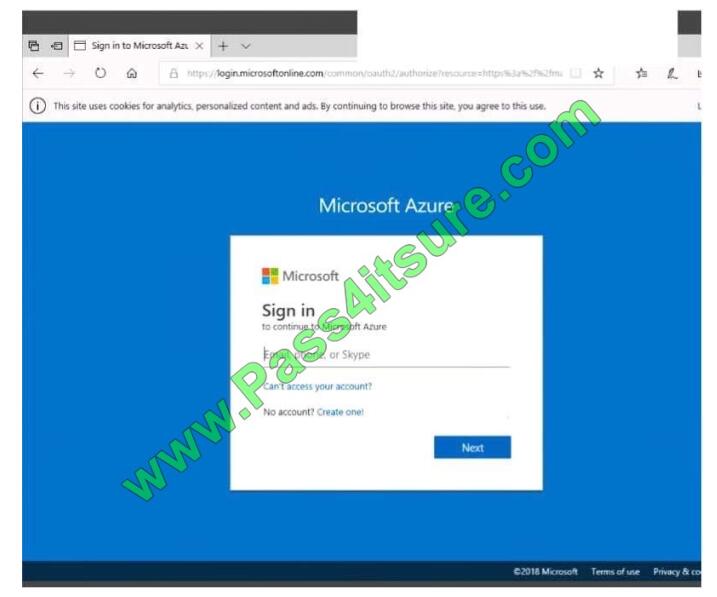
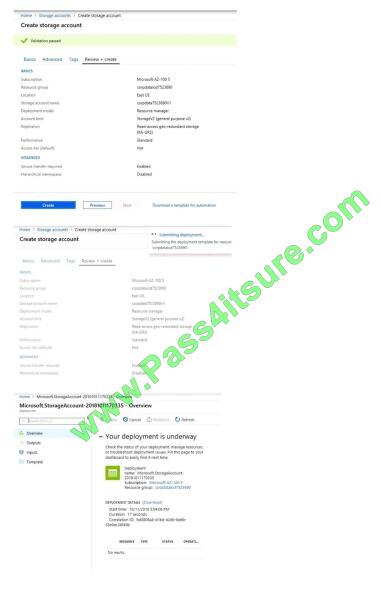

When you are finished performing all the tasks, click the `Next\\’ button. Note that you cannot return to the lab once you
click the `Next\\’ button. Scoring occur in the background while you complete the rest of the exam.
Overview
The following section of the exam is a lab. In this section, you will perform a set of tasks in a live environment. While
most functionality will be available to you as it would be in a live environment, some functionality (e.g., copy and paste,
ability
to navigate to external websites) will not be possible by design. Scoring is based on the outcome of performing the tasks
stated in the lab. In other words, it doesn\\’t matter how you accomplish the task, if you successfully perform it, you will
earn credit for that task.
Labs are not timed separately, and this exam may have more than one lab that you must complete. You can use as
much time as you would like to complete each lab. But, you should manage your time appropriately to ensure that you
are
able to complete the lab(s) and all other sections of the exam in the time provided.
Please note that once you submit your work by clicking the Next button within a lab, you will NOT be
able to return to the lab.
To start the lab
You may start the lab by clicking the Next button.
You plan to migrate a large amount of corporate data to Azure Storage and to back up files stored on old hardware to
Azure Storage.
You need to create a storage account named corpdata7523690n1 in the corpdatalog7523690 resource group. The
solution must meet the following requirements:
Corpdata7523690n1 must be able to host the virtual disk files for Azure virtual machines.
The cost of accessing the files must be minimized.
Replication costs must be minimized.
What should you do from the Azure portal?
A. Answer: See solution below.
Correct Answer: A
Step 1: In the Azure portal, click All services. In the list of resources, type Storage Accounts. As you begin typing, the list
filters based on your input. Select Storage Accounts.
Step 2: On the Storage Accounts window that appears, choose Add.
Step 3: Select the subscription in which to create the storage account. Step 4: Under the Resource group field, select
corpdatalog7523690.

Step 5: Enter a name for your storage account: corpdata7523690n1 Step 6: For Account kind select: General-purpose
v2 accounts (recommended for most scenarios) General-purpose v2 accounts is recommended for most scenarios. .
General-purpose v2 accounts deliver the lowest per-gigabyte capacity prices for Azure Storage, as well as industrycompetitive transaction prices. Step 7: For replication select: Read-access geo-redundant storage (RA-GRS) Readaccess geo-redundant storage (RA-GRS) maximizes availability for your storage account. RA- GRS provides read-only
access to the data in the secondary location, in addition to geo-replication across two regions.
References: https://docs.microsoft.com/en-us/azure/storage/common/storage-quickstart-create-account
https://docs.microsoft.com/en-us/azure/storage/common/storag
QUESTION 5
You need to meet the technical requirement for VM4.
What should you create and configure?
A. an Azure Notification Hub
B. an Azure Event Hub
C. an Azure Logic App
D. an Azure services Bus
Correct Answer: B
Scenario: Create a workflow to send an email message when the settings of VM4 are modified. You can start an
automated logic app workflow when specific events happen in Azure resources or third-party resources. These
resources can publish those events to an Azure event grid. In turn, the event grid pushes those events to subscribers
that have queues, webhooks, or event hubs as endpoints. As a subscriber, your logic app can wait for those events from
the event grid before running automated workflows to perform tasks – without you writing any code.
References: https://docs.microsoft.com/en-us/azure/event-grid/monitor-virtual-machine-changes-event-grid-logic- app
QUESTION 6
You have an Azure subscription named Subscription1. Subscription1 contains the resource groups in the following
table.
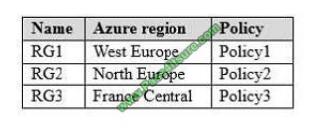
RG1 has a web app named WebApp1. WebApp1 is located in West Europe. You move WebApp1 to RG2. What is the
effect of the move?
A. The App Service plan to WebApp1 moves to North Europe. Policy2 applies to WebApp1.
B. The App Service plan to WebApp1 moves to North Europe. Policy1 applies to WebApp1.
C. The App Service plan to WebApp1 remains to West Europe. Policy2 applies to WebApp1.
D. The App Service plan to WebApp1 remains to West Europe. Policy1 applies to WebApp1.
Correct Answer: C
You can move an app to another App Service plan, as long as the source plan and the target plan are in the same
resource group and geographical region. The region in which your app runs is the region of the App Service plan it\\’s in.
However, you cannot change an App Service plan\\’s region.
References: https://docs.microsoft.com/en-us/azure/app-service/app-service-plan-manage
QUESTION 7
You have an Azure Service Bus.
You need to implement a Service Bus queue that guarantees first in first-out (FIFO) delivery of messages.
What should you do?
A. Set the Lock Duration setting to 10 seconds.
B. Enable duplicate detection.
C. Set the Max Size setting of the queue to 5 GB.
D. Enable partitioning.
E. Enable sessions.
Correct Answer: E
Through the use of messaging sessions you can guarantee ordering of messages, that is first-in-first- out (FIFO)
delivery of messages.
References:
https://docs.microsoft.com/en-us/azure/service-bus-messaging/service-bus-azure-and-service-bus- queues-comparedcontrasted
QUESTION 8
Click to expand each objective. To connect to the Azure portal, type https://portal.azure.com in the browser address
ba

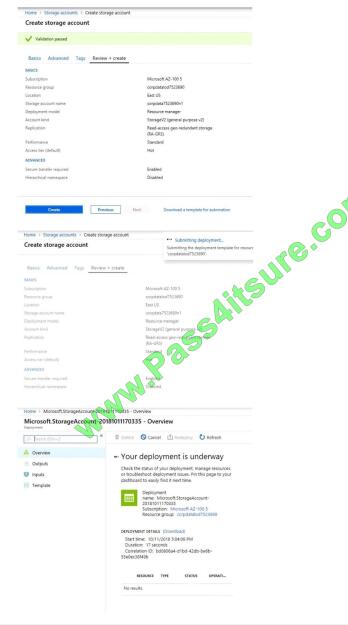
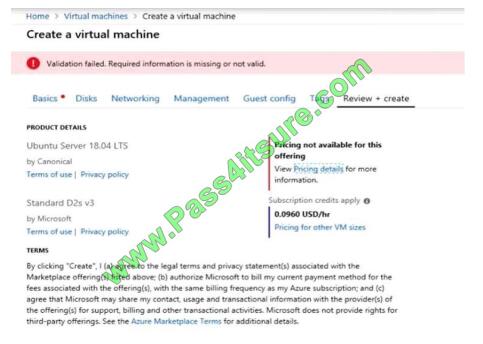
When you are finished performing all the tasks, click the `Next\\’ button. Note that you cannot return to the lab once you
click the `Next\\’ button. Scoring occur in the background while you complete the rest of the exam.
Overview
The following section of the exam is a lab. In this section, you will perform a set of tasks in a live environment. While
most functionality will be available to you as it would be in a live environment, some functionality (e.g., copy and paste,
ability
to navigate to external websites) will not be possible by design. Scoring is based on the outcome of performing the tasks
stated in the lab. In other words, it doesn\\’t matter how you accomplish the task, if you successfully perform it, you will
earn credit for that task.
Labs are not timed separately, and this exam may have more than one lab that you must complete. You can use as
much time as you would like to complete each lab. But, you should manage your time appropriately to ensure that you
are
able to complete the lab(s) and all other sections of the exam in the time provided.
Please note that once you submit your work by clicking the Next button within a lab, you will NOT be able to return to
the lab.
To start the lab
You may start the lab by clicking the Next button.
You need to deploy two Azure virtual machines named VM1003a and VM1003b based on the Ubuntu Server 17.10
image. The deployment must meet the following requirements:
Provide a Service Level Agreement (SLA) of 99.95 percent availability.
Use managed disks.
What should you do from the Azure portal?
A. Answer: See solution below.
Correct Answer: A
1.Open the Azure portal.
2.On the left menu, select All resources. You can sort the resources by Type to easily find your images.
3.Select the image you want to use from the list. The image Overview page opens.
4.Select Create VM from the menu.
5.Enter the virtual machine information.
Select VM1003a as the name for the first Virtual machine.
The user name and password entered here will be used to log in to the virtual machine. When complete, select OK. You
can create the new VM in an existing resource group, or choose Create new to create a new resource group to store
the
VM.
6.Select a size for the VM. To see more sizes, select View all or change the Supported disk type filter.
7.Under Settings, make changes as necessary and select OK.
8.On the summary page, you should see your image name listed as a Private image. Select Ok to start the virtual
machine deployment.
Repeat the procedure for the second VM and name it VM1003b.
References: https://docs.microsoft.com/en-us/azure/virtual-machines/windows/create-vm- generalized-managed
QUESTION 9
You have an Azure subscription.
You have 100 Azure virtual machines.
You need to quickly identify underutilized virtual machines that can have their service tier changed to a less expensive
offering.
Which blade should you use?
A. Metrics
B. Customer insights
C. Monitor
D. Advisor
Correct Answer: D
References: https://docs.microsoft.com/en-us/azure/advisor/advisor-cost-recommendations
https://docs.microsoft.com/bs-latn-ba/azure/cost-management/tutorial-acm-opt- recommendations
QUESTION 10
You have an Azure Active Directory (Azure AD) tenant.
You have an existing Azure AD conditional access policy named Policy1. Policy1 enforces the use of Azure AD-joined
devices when members of the Global Administrators group authenticate to Azure AD from untrusted locations.
You need to ensure that members of the Global Administrators group will also be forced to use multi- factor
authentication when authenticating from untrusted locations.
What should you do?
A. From the multi-factor authentication page, modify the service settings.
B. From the multi-factor authentication page, modify the user settings.
C. From the Azure portal, modify grant control of Policy1.
D. From the Azure portal, modify session control of Policy1.
Correct Answer: C
There are two types of controls: Grant controls – To gate access Session controls – To restrict access to a session Grant
controls oversee whether a user can complete authentication and reach the resource that they\\’re attempting to sign-in
to. If you have multiple controls selected, you can configure whether all of them are required when your policy is
processed. The current implementation of Azure Active Directory enables you to set the following grant control
requirements:
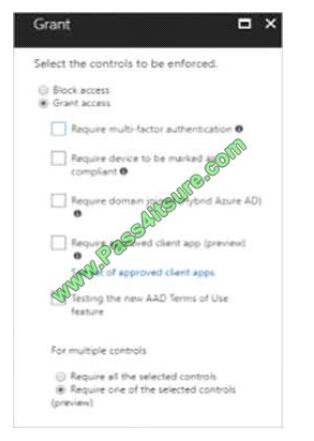
References: https://blog.lumen21.com/2017/12/15/conditional-access-in-azure-active-directory/
QUESTION 11
You have an Azure subscription that contains three virtual networks named VNet1, VNet2, VNet3.
VNet2 contains a virtual appliance named VM2 that operates as a router. You are configuring the virtual networks in a
hub and spoke topology that uses VNet2 as the hub network.
You plan to configure peering between VNet1 and VNet2 and between VNet2 and VNet3. You need to provide
connectivity between VNet1 and VNet3 through VNet2.
Which two configurations should you perform? Each correct answer presents part of the solution.
NOTE: Each correct selection is worth one point.
A. On the peering connections, allow forwarded traffic.
B. On the peering connections, allow gateway transit.
C. Create route tables and assign the table to subnets.
D. Create a route filter.
E. On the peering connections, use remote gateways.
Correct Answer: BE
Allow gateway transit: Check this box if you have a virtual network gateway attached to this virtual network and want to
allow traffic from the peered virtual network to flow through the gateway. The peered virtual network must have the Use
remote gateways checkbox checked when setting up the peering from the other virtual network to this virtual network.
References:
https://docs.microsoft.com/en-us/azure/virtual-network/virtual-network-manage- peering#requirements-and-constraints
QUESTION 12
You need to add a deployment slot named staging to an Azure web app named [email protected]. The
solution must meet the following requirements:
When new code is deployed to staging, the code must be swapped automatically to the production slot. Azure-related
costs must be minimized.
What should you do from the Azure portal?
A. Answer: See explanation below.
Correct Answer: A
Step 1:
Locate and open the [email protected] web app.
1.In the Azure portal, on the left navigation panel, click Azure Active Directory.
2.In the Azure Active Directory blade, click Enterprise applications.
Step 2:
Open your app\\’s resource blade and Choose the Deployment slots option, then click Add Slot.

Step 3:
In the Add a slot blade, give the slot a name, and select whether to clone app configuration from another existing
deployment slot. Click the check mark to continue. The first time you add a slot, you only have two choices: clone
configuration
from the default slot in production or not at all.
References:
https://docs.microsoft.com/en-us/azure/app-service/web-sites-staged-publishing
QUESTION 13
You have an azure subscription named Subscription that contains the resource groups shown in the following table.

In RG1, you create a virtual machine named VM1 in the East Asia location.
You plan to create a virtual network named VNET1.
You need to create VNET, and then connect VM1 to VNET1.
What are two possible ways to achieve this goal? Each correct answer presents a complete a solution.
NOTE: Each correct selection is worth one point.
A. Create VNET1 in RG2, and then set East Asia as the location.
B. Create VNET1 in a new resource group in the West US location, and then set West US as the location.
C. Create VNET1 in RG1, and then set East Asia as the location
D. Create VNET1 in RG1, and then set East US as the location.
E. Create VNET1 in RG2, and then set East US as the location.
2019 New Exam AZ-103 Dumps with PDF download: https://drive.google.com/open?id=1IfQGWiZqutQ6oU0sqyAZtQUJ3dcm2GgE
Summarize:
It is important point to get latest Microsoft Azure az-103 dumps, it is a big tactic a key to win Microsoft AZ-103 exam success. Go to https://www.pass4itsure.com/az-103.html,updated practice test questions to study and pass quickly and easily.